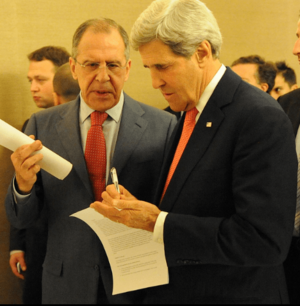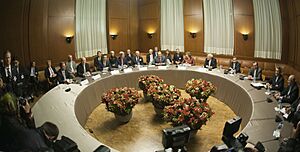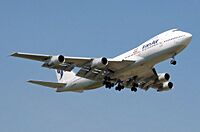Joint Plan of Action facts for kids
The Joint Plan of Action (برنامه اقدام مشترک), also known as the Geneva interim agreement (Persian: توافق هستهای ژنو), was an important agreement. It was signed on 24 November 2013 in Geneva, Switzerland. The agreement was made between Iran and a group of powerful countries called the P5+1. These countries included China, France, Germany, Russia, the United Kingdom, and the United States.
This plan was a short-term deal. It asked Iran to temporarily stop some parts of its nuclear program. In return, some economic sanctions on Iran were reduced. Both sides hoped this would lead to a longer-lasting agreement. This was the first official agreement between the United States and Iran in 34 years. The agreement started to be put into action on 20 January 2014.
The Joint Plan of Action and the talks that followed led to another agreement in April 2015. This was called the Iran nuclear deal framework. Then, in July 2015, a final agreement was reached. It was named the Joint Comprehensive Plan of Action.
Contents
Why the Agreement Was Needed
Iran's Nuclear Program History

Iran's nuclear program has been a topic of discussion for many countries since 2002. That year, a group from Iran shared information about two nuclear facilities that were not known to the public.
The International Atomic Energy Agency (IAEA) is a group that checks if nuclear activities are peaceful. In 2006, the IAEA told the UN Security Council about Iran's nuclear program. They found that Iran was not following its duties under the Nuclear Non-Proliferation Treaty (NPT). Because Iran did not follow these rules, the UN Security Council voted four times to put economic sanctions against Iran on Iran. These sanctions are like penalties. The Council asked Iran to work fully with the IAEA. They also asked Iran to stop all activities related to enriching uranium.
Sanctions on Iran
Besides the UN sanctions, the United States and the European Union also added their own sanctions. These penalties aimed at Iran's oil and gas exports. They also targeted its car industry, banking system, and access to international money.
New Leadership in Iran
In June 2013, Iran held a presidential election. Hassan Rouhani won this election. He promised to be more moderate and work with other countries. He wanted to solve the nuclear program issues and end Iran's isolation. Rouhani had been Iran's main nuclear negotiator from 2003 to 2005.
Also, officials from the Obama administration in the U.S. had secret talks with Iranian officials in 2013. They discussed if an agreement on Iran's nuclear program was possible. These secret meetings happened five times in Oman. U.S. President Barack Obama personally approved these talks. They started in March 2013 in Muscat. At that time, Mahmoud Ahmadinejad was Iran's president. Obama told Israeli Prime Minister Benjamin Netanyahu about these talks in September 2013.
At the same time as the P5+1 agreement, the IAEA and Iran also agreed to work together. They planned to answer questions about Iran's nuclear program. This included activities that might be linked to nuclear weapons.
Key People in the Talks
-
Iran
Mohammad Javad Zarif, Minister of Foreign Affairs
How the Agreement Was Reached
Previous Discussions
Before this agreement, Iran and the P5+1 group had several talks. These meetings were led by Catherine Ashton from the European Union. They met in cities like Almaty in Kazakhstan and Istanbul in Turkey in 2013. They also met in Geneva in November 2013. However, none of these earlier talks led to a deal. The groups agreed to meet again on 20 November.
The talks on 20 November included the foreign ministers from each country. Lady Ashton and Iran's foreign minister, Mohammad Javad Zarif, started the talks. Then, the countries began their own separate discussions.
Secret Meetings
Two U.S. officials, William J. Burns and Jake Sullivan, were also at the Geneva talks. But their presence was not announced. They stayed in a different hotel and used service entrances. Burns and Sullivan were important in the secret talks that President Obama sent to Oman. Burns had even met secretly with Iranian officials as early as 2008.
What the Agreement Said
The Geneva Accord was signed on 24 November 2013. It was an interim, or temporary, deal. It asked Iran to freeze important parts of its nuclear program. In return, some sanctions were reduced. Both sides aimed to work towards a long-term agreement.
Here are some key things Iran agreed to do:
- All uranium enriched above 5% would be made less powerful or changed. Iran would not add new uranium at the 3.5% enrichment level.
- No new machines called centrifuges would be put in place. Centrifuges are used to enrich uranium.
- Many centrifuges at the Natanz enrichment facility and Fordow enrichment facility would be stopped. Iran would not use its advanced centrifuges for enrichment.
- Iran would not build any new uranium enrichment or nuclear fuel processing facilities.
- No fuel would be made, tested, or sent to the Arak nuclear power plant. Iran would also share details about this reactor's design.
- The IAEA would be allowed to visit Natanz and Fordow every day. Some areas would have cameras watching 24 hours a day. The IAEA would also visit Iran's uranium mines and centrifuge factories.
- Iran would answer IAEA questions about any possible military parts of its nuclear program. They would also provide information as part of an Additional Protocol.
In exchange, Iran would receive about US$7 billion (about £4.3 billion) in relief from sanctions. Also, no new sanctions would be put in place. The agreement set a six-month period to work on a more complete follow-up agreement. This would decide Iran's nuclear relationship with the world for the long term.
Sanctions on Iran's car industry were also stopped. Iran was also allowed to buy spare parts for its older civil airplanes. This was to help with flight safety.
According to an expert named David Albright, stopping Iran's 20% enriched uranium would increase the time needed for Iran to make a nuclear weapon. It would go from 1–1.6 months to 1.9–2.2 months.
The agreement did not stop Iran from making parts for its nuclear facilities away from the main sites. But these parts could not be installed. One diplomat said this "loophole" was small. Iran's foreign minister, Mohammad Javad Zarif, said Iran did not plan to increase the size of the Arak site. But he said construction would continue there.
Uranium Enrichment and Rights
The NPT says countries have a "right" to use nuclear energy for peaceful reasons. This must follow the treaty's rules about not spreading nuclear weapons. These rules say that non-nuclear countries must not get nuclear weapons. They also must let the IAEA check all their nuclear material.
Iran said that the NPT gives it the right to enrich uranium. Iran's Supreme Leader, Ali Khamenei, said that the right to enrich was a "red line" for Iran. In the past, the U.S. and European countries argued that Iran should give up this right. This was because of its secret nuclear activities.
The temporary agreement was a compromise. It did not clearly say if Iran had a right to enrich uranium. It mentioned Iran's "right to nuclear energy for peaceful purposes." It also allowed Iran to continue some enrichment activities in the first phase. For a long-term solution, the agreement said Iran could "fully enjoy its right to nuclear energy for peaceful purposes." This would be under the NPT rules. It also said a long-term solution "could involve a mutually defined enrichment program." This program would have limits and ways to show it was peaceful. But a note made it clear that "nothing is agreed until everything is agreed."
A U.S. official said that the United States did not recognize Iran's right to enrich uranium. They said the document did not mention recognizing such a right.
Putting the Agreement into Action
The countries involved in the agreement announced that it would start on 20 January 2014.
Iran's negotiator, Araghchi, said that some parts of the agreement were explained in a secret 30-page "side agreement." He said it included information about a group that would watch over the agreement. Later, a U.S. official denied there was any secret agreement. The full text of the agreement was not made public. The White House did release a summary of technical details on 16 January.
President Barack Obama welcomed the news. He said: "Beginning 20 January, Iran will for the first time start eliminating its stockpile of higher levels of enriched uranium." He also said Iran would dismantle some of the equipment used for enrichment. Iran's Deputy Foreign Minister Abbas Araghchi said Obama's use of the word "dismantle" was not right.
The agreement began on 20 January 2014. The IAEA confirmed that Iran had started to reduce its nuclear activities. This was the first step to put the deal into action. After this, the United States and the EU partly lifted their sanctions. Iran received its first payment of $550 million in sanctions relief on 1 February. Iran was also set to receive five more payments of $550 million. They would also get $900 million for making its enriched uranium less powerful. European shipping and insurance companies were also allowed to work with Iranian oil shipments to six countries. These countries were not facing U.S. sanctions.
See also
- Comprehensive agreement on the Iranian nuclear program
- List of Middle East peace proposals
- InterContinental Geneva











